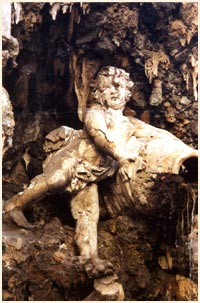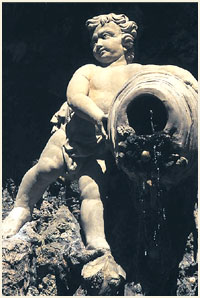The Nyphaeum, being situated in an open place, as well as having to live with the constant presence of water, is also subject to progressive deterioration caused by weathering; but it is water itself which subjects it to a series of phenomena of changes common to these environmental conditions.
The lack of periodical maintenance can only help to make the deterioration more rapid.
The materials themselves, used in the construction of the building, and worse, those used wrongly during subsequent interventions have produced serious preservation problems.
First of all let's look at the original materials: the metal components used inside the forms, used as a support for the natural elements, had progressively changed due to oxidation, and this deformation thus led to the cracking or the breaking off of parts of the form as the stability of the pieces was no longer secure. Also many parts of the natural coating fell away.
The presence of cement mortar, with a particularly high quantity of soluble salts, used in the works carried out in the eighteenth and nineteenth centuries, had led to the formation of vast areas of efflorescence plaguing the surfaces and leading to their disintegration.
Also the numerous shrubs, with their roots under the plaster, have been the cause of further disintegration of the superficiallayers of mortar, just as the wide presence of bacterial micro-organisms, moss and lichen has brought about erosion of the stone surfaces and of the stucco.
The continuous draining of rainwater and of that used to supply the nymphaeum along the side walls of the lower cave has led to the formation of thick calcareous deposits.
The cleaning operation started with an accurate and repeated washing with demineralised water, followed by the removal of the badly made restorations in cement mortar, using a scalpel.
The stuccoing and the seals were made using a lime-based mortar and a suitably coloured marble powder; finally all the surfaces were protected with a layering of siloxanic resins.

Putto before the restoration work.

Putto after the restoration work.
